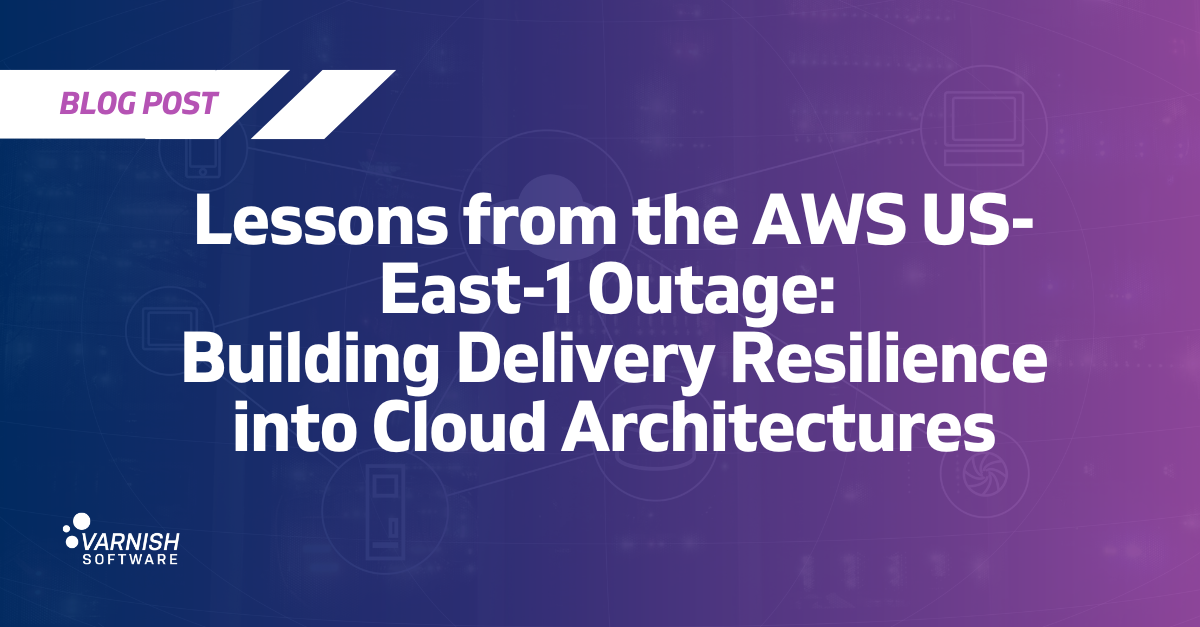On October 20 2025, AWS experienced a significant disruption in its US-East-1 region, causing elevated error rates and latencies across multiple services. The impact was immediate, with a wide range of consumer and enterprise platforms experiencing slowdowns or downtime as one of the most relied-upon cloud regions in the world encountered service degradation.
Cloud reliability and service availability are not the same thing. Even with multi-zone redundancy, a regional failure can still affect business continuity if critical paths depend on that region’s control plane or data layer.
Delivery-Layer Continuity
Disaster recovery strategies often focus on replicating infrastructure across regions or providers. But continuity at the content delivery layer, where users and systems actually interact, can be overlooked. If all live requests still route through a single origin or region, any failure there disrupts performance, regardless of how much redundancy exists underneath.
Caching provides a practical bridge. By maintaining local or distributed copies of frequently accessed data (HTML pages, API responses, configuration files, build artifacts) organizations can continue serving users and systems even when an origin is unreachable. In this sense, caching is a resilience mechanism as well as a performance optimization.
Caching Can Mitigate Cloud-Level Disruptions
Varnish Software solutions provide a cache layer that decouples user experience and system performance from backend availability. By storing frequently accessed content and responses closer to users, it reduces dependency on live backends and provides a buffer against network or cloud disruptions. When data, APIs, or application responses are locally available, delivery can continue even if upstream services slow down or go offline.
Varnish is a software-defined caching engine that accelerates delivery and maintains availability across any infrastructure. By operating as a programmable layer between users and origins, it gives organizations fine-grained control over performance, routing, and resilience. Core capabilities include:
- Serve-stale mode: When origins or APIs fail, Varnish can serve the most recent valid objects, keeping sites, dashboards, and endpoints live until recovery.
- Health checking and backend probes: Continuous monitoring ensures traffic is only routed to healthy origins, reducing cascading failures.
- Persistent cache: Cached data can be written to object storage, providing durability and fast recovery even after node restarts or redeployments. This enables long-lived cache layers that survive outages or maintenance cycles.
- Hybrid and multi-cloud deployment: Varnish nodes can operate in parallel across AWS, on-premises, or alternative cloud providers, maintaining independent delivery paths.
- Cluster-wide cache management: Coordinated invalidation and purging simplify recovery and ensure consistency once services return to normal.
Where This Matters
Caching for resilience applies across multiple domains:
- Web and APIs: Maintain functional websites, portals, and application endpoints even when backend or database connectivity is lost.
- Media and streaming: Ensure manifests, metadata, and assets continue to load under partial outages.
- DevOps and CI/CD: Cache and serve Docker images, build artifacts, and package dependencies from Varnish rather than from remote registries when a cloud service or region fails. Developers stay productive when upstream repositories are slow or unavailable.
The goal is to protect availability, preserve performance, and sustain workflow continuity regardless of upstream conditions.
Strategic Takeaways
The AWS outage highlights the need to separate cloud dependency from service reliability. When designing for high availability, consider:
- Where does delivery resilience live in our stack? Is the caching layer independent of a single region or provider?
- Can we continue serving essential web, API, and CI workloads during an outage?
- Are caches persistent and recoverable, or do they need to rebuild after downtime?
- How quickly can users and teams return to normal operation after a regional failure?
Regional cloud outages are inevitable. Business disruption is not. Implementing an independent caching layer with persistent storage, intelligent failover, and multi-cloud reach, organizations can sustain both customer-facing and internal systems when their primary cloud experiences instability. Performance engineering and resilience engineering are converging. Caching at the delivery layer is where that convergence can deliver real value.
/VS-logo-2020-197x60.png?width=136&height=60&name=VS-logo-2020-197x60.png)

